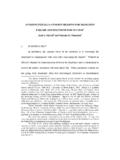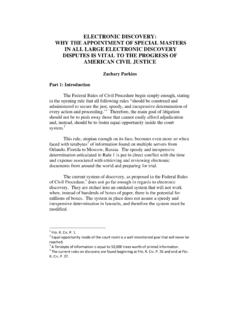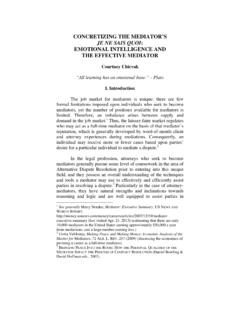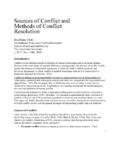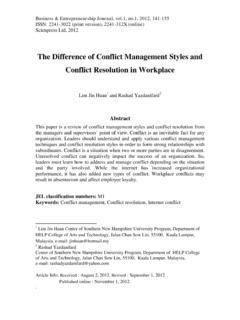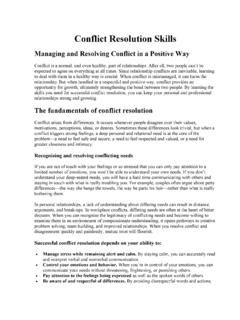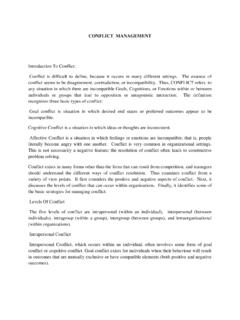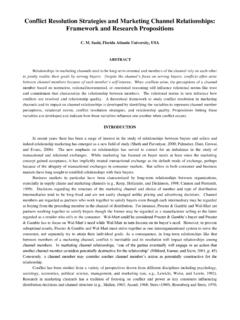Transcription of CONFLICT MANAGEMENT IN HOSPITAL SYSTEMS: …
1 CONFLICT MANAGEMENT IN HOSPITAL SYSTEMS: NOT JUST FOR LEADERSHIP Dale C. Hetzler, Deanne R. Messina, Kimberly J. Smith I. Why? Experience tells us that the majority of errors in healthcare come from communication Our view is that these problems stem in large part from conflicts , what one writer has called the invisible CONFLICT that exists in Whether small or large, the important characteristic of conflicts for this discussion is that they exist, and they make it less likely that one healthcare person will communicate to another what may be important to the treatment outcome for the patient.
2 Taking this thought one step further, if communication before an event occurs is critical to an outcome, then so is the communication that occurs after an event. It is this post-occurrence communication that dictates whether the institution has the ability to learn and improve from the experience, and also whether they have the ability to deal fairly and openly with the providers, patient and family involved. Because good communication before and after care is the essence of good healthcare, it will be important for healthcare enterprises to anticipate that communication skills and CONFLICT skills will become primary predictors of the organization s ability to progress in both quality improvement and patient safety, and will therefore equip its caregivers and administrators with these skills.
3 For those who do adopt this approach, they can expect lower turn-over, less burnout, increased patient loyalty and lower rates of medical 1 Joint Commission Resources: 2011 HOSPITAL Accreditation Standards. Oakbrook Terrace, Ill.: Joint Commission on Accreditation of Healthcare Organizations, 2011. 2 Matz, D.: The Inevitability and Perils of Invisible Health Care CONFLICT . Hamline J Pub L & Pol y 29(2):243-248. Summer 2005 3 Angermeier, et al: The Impact of Participative MANAGEMENT Perceptions on Customer Service, Medical Errors, Burnout, and Turnover Intentions.
4 J HC Mgmt 54(2) Mar/Apr 2009. The Joint Commission has issued a Leadership Standard that requires CONFLICT MANAGEMENT process to be available to administration, medical staff leadership and the governing Similar requirements have been added for physician leaders. Our discussion will not be addressing the need for CONFLICT MANAGEMENT process or policy for just leadership, but instead will propose how to install a CONFLICT MANAGEMENT -based approach for patients who have questions about the outcome of care and for employees and managers who are dealing with CONFLICT on the front lines in the environment of care.
5 II. When Events Occur Existing Systems Create CONFLICT Healthcare is unique in many ways. At the same time it is similar to other enterprises in the ways in which people behave when something happens that could give rise to liability or professional discipline. The event could be an unintended outcome, the filing of a peer review grievance, the filing of a lawsuit or receipt of an alert from a Patient Safety Organization. Many institutional processes and structures exist that describe the preferred communications pathways for dealing with these events.
6 These structures each depend on people putting aside their personal fears and emotional filters and behaving professionally. These processes also exist independently of each other for the most part. Because each process has a different purpose and owner, this independence is intentional in many respects. Whether it is due to the structure necessary for applicability of a legally-recognized privilege that protects information from discovery (such as peer review) or the historical separation between quality functions and direct administrative processes, when an event occurs, several independent systems engage which compete for -- and often limit access to -- critical information necessary to reduce CONFLICT and to allow the organization to learn and improve.
7 When an event has occurred and the patient or family has questions about the outcome of care, the facility and each employee and provider should have the same moral and ethical 4 Joint Commission Resources: 2011 HOSPITAL Accreditation Standards. Oakbrook Terrace, Ill.: Joint Commission on Accreditation of Healthcare Organizations, 2011. commitment to the patient as when the patient initially asked for All should continue to act in the best interest of the patient.
8 The long-term interests of the institution are also best served by the same professional and disciplined behaviors. But it is very difficult to teach and learn how best to behave when something has gone wrong. A. Event Response and Activities For the sake of discussion, we will be using as an example the unintended outcome of care. Treatment has been rendered, and in spite of the intentions and actions of all involved to create the ideal outcome for the patient from the medical encounter, the patient has not responded well to the treatment.
9 The outcome of treatment is unexpected. Not knowing what the cause of the outcome may be, the event is entered into the HOSPITAL s occurrence reporting system . The Event Dynamics Chart [Fig. 1] illustrates the majority of processes that exist in healthcare relating to the occurrence of situations that call into question the appropriateness of the outcome of care. It is just a partial list, as many other department processes cascade from those listed. Documentation In the left-hand quadrant of Fig. 1 are those items that pre-exist any known occurrence.
10 These are the things that may lead up to the event, or be relevant to understanding the underlying environment of the outcome, such as the medical record, policies, documents, processes and people who may be involved in care or members of the patient family. Documents would include any policies relating to the methods used to treat the patient, as well as processes relating to delivery of care, communication among care givers, ordering and delivering pharmaceuticals, and diagnostic testing. Documents would also include the ordinary business records created for billing and operations, and the elements of the patient medical record.

